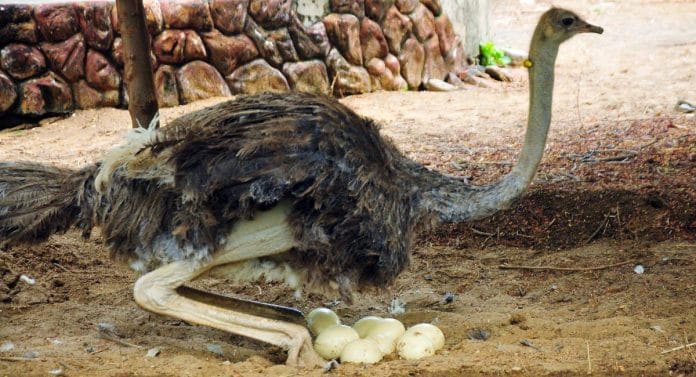A team of researchers from the US, Germany, and Australia, including Anil Kumar Devara, an assistant professor from MSU Baroda, recently discovered the world’s oldest ostrich nest in Andhra Pradesh. The nest measured 9-10 feet in diameter and likely contained 911 eggs. The team also discovered about 3,500 fragments of ostrich eggshells concentrated in a small area.
This remarkable finding not only expands the understanding of megafaunal birds—large flightless birds weighing over 40 kg—but also conclusively proves the presence of ostriches in the prehistoric Indian subcontinent as early as 41,000 years ago.
However, archaeologists and researchers have been documenting fossilised ostrich eggshell fragments from Shivalik Hills to Peninsular India since the 1930s. In fact, the earliest evidence was recorded in 1884. What increased application of science and technology has done is that it has cemented and validated these findings in archaeological data.
It started with the 2017 study where researchers used ancient DNA analysis of fossilised ratite eggshells to provide molecular evidence of ostriches in India. Now the recent finding of the world’s oldest ostrich nest has revolutionised our understanding of the evolutionary history of the bird and their movement in the prehistoric landscape of the Indian subcontinent.
Also read: Collapse of Harappan Civilisation? Art of making shell bangles transcends time and boundaries
The big bird in India
Ostriches are known today as natives of the African continent. However, historically, they were once found in Arabia and Asia, with the species spreading as far as China and Mongolia. Ecological and environmental changes over time concentrated their population in Africa, but this is a simplistic explanation.
The biogeographical movement of ostriches began during the early Cretaceous period—130 to 100 million years ago—coinciding with the great continental drift. The breakup of the supercontinent into Africa, South America, India, Madagascar, Antarctica, and Australia affected both flora and fauna. For instance, around 80 million years ago, when the Indo-Madagascar landmass split into two, elephant birds remained in Madagascar while ostriches were found in India.
For the next 60 million years, India and the rest of Asia were home to ostriches before the birds hopped back to Africa via Arabia. This biogeographical movement and their reverse migration to Africa around 20 million years ago were documented in a 2017 study published in the PLOS One journal. The study focused on ancient DNA analysis of samples collected from excavation sites like Chavni Baroda, Anjar, Nagda, Runija, Khajurna, and Ravishankar Nagar in Madhya Pradesh, dating back to the Late Pleistocene era, about 25,000 to 40,000 years ago.
According to the scientists, DNA hotspots were detected in fossilised eggshell fragments of ratites (dated to 25,000 BP) using confocal laser scanning microscopy (CLSM). The DNA isolated from five eggshell fragments revealed a 92 per cent match with the modern-day African ostrich, consolidating their presence in the subcontinent and adding more layers to the discovery of the ostrich nest in Andhra Pradesh.
Also read: Rajgir’s rediscovery is as complex as its history–12 archaeologists unravelled its mysteries
Sites of importance
Long before it was scientifically proven that ostriches were native to South Asia thousands of years ago, archaeologists had collected eggshell ornaments like beads from many archaeological sites in Africa as well as India. The site of Patne in Maharashtra, excavated by SA Sali in 1971-73, yielded large quantities of eggshell fragments and beads—engraved and plain—from the last phase of an Upper Palaeolithic open-air camping site.
Archaeologist VS Wakankar also found two small ostrich eggshell beads around the neck of a skeleton from the Upper Palaeolithic deposit in the Bhimbetka rock shelters. One ostrich eggshell piece with engraving was reported by Wakankar in 1978 from Ravishankar Nagar in Bhopal.
Observing the widespread ostrich eggshell fragments and artefacts, The Prehistoric Man–Ostrich Project was initiated by Wakankar in 1980. Under this project, hundreds of prehistoric sites yielding eggshell fragments were reported. The research aimed to understand the making of these artefacts from eggshell fragments.
Being about 2 mm thick and strong, it requires precision and skill to carve an ostrich eggshell fragment suitable for either a bead or pendant. Once the carving is done, the fragment is perforated with a borer and then polished. Tools like anvils and borers were used to make these items. The project concluded that a high degree of control and precision was required to make these artefacts, a skill that Upper Palaeolithic people were aware of.
It is also interesting to note that the technique of manufacturing these artefacts was passed down through generations and perfected. However, the spatial spread of these objects calls for investigating the communication channels between prehistoric societies as early as the Upper Palaeolithic period.
One such work was conducted by Jennifer Miller and Yiming Wang in their 2021 study—’Ostrich eggshell beads reveal 50,000-year-old social network in Africa’—published in Nature. They analysed beads from 31 sites across the African continent, noting their thickness, diameter, and other morphological characteristics, and found that all of them were ‘identical’ in nature. This led researchers to suggest that around 50,000 years ago in Africa, a social network existed.
These artefacts indicate the beginning of modifications made to shape the eggshell fragments into a variety of forms for aesthetic and practical purposes, uncovering another layer of human intelligence.
It’s fascinating to see how one piece of evidence, one study, can change our understanding of our layered past, buried deep in time. While recent findings consolidated the presence of the oldest ostrich nest in southern India, they also added more meaning to the researchers’ work that detailed the spread of these mighty birds in the subcontinent and their reverse migration to Africa. It also validates all the past research done by numerous scholars who investigated the remnants of prehistoric society and its interaction with ostriches.
Disha Ahluwalia is an archaeologist and junior research fellow at the Indian Council Of Historical Research. Views are personal. She tweets @ahluwaliadisha.
(Edited by Aamaan Alam Khan)






